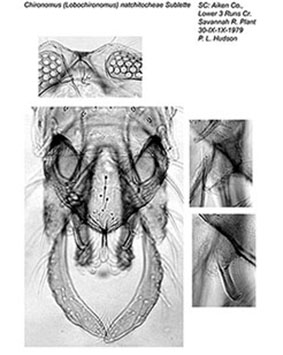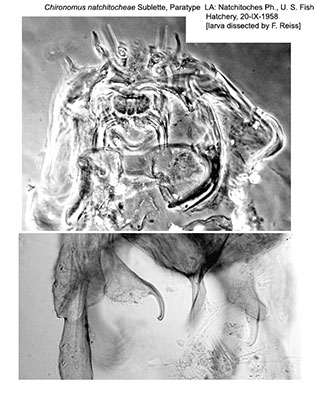Species 4n. Benthalia(?) natchitocheae (Sublette 1964).Einfeldia (s.l.) Oliver 1981, Epler 2001 Adult:  Head with frontal tubercle, hypopygium, and Superior volsella (on right). (Photos courtesy of J.E. Sublette) Wing length 2.39-2.70. AR 2.82-3.10. No beard. Head brownish; frontal tubercles developed; palp segments (2-5): 5 : 12 : 20 : 27; P5/P4 1.35, P5/P3 2.25. Thorax yellowish brown, vittae, postnotum and sternopleuron blackish brown, mesonotum with a slight central hump. Abdomen entirely blackish brown. Legs darkened on distal third of femur and on tarsi. Leg proportions (units):
Tergite IX with setae from anterior to distal: about 5 setae almost linear on anterior part, and smaller setae flanking the anal point. Superior volsella with chitinous hook on a pedicel covered with small setae and some longer setae (as above); Inferior volsella with a terminal knob covered in setae and reaching just beyond end of the anal point and to about 1/3 along the gonostylus, which hardly narrows distally; anal point broadening towards the tip. Female: (Allotype)Wing length 3.15 mm. Coloration essentially as in male. Leg proportions (units):
Pupa Length about 8 mm; almost entirely blackish. Larva One pair of ventral tubules. Gula darkened, apotome without fenestra; dark spot at base of antenna.  Epipharyngeal region of paratype larva (above) and SVo of paratype male (below). Cytology: Not known. Found: Louisiana – U.S. Fish Hatchery, Natchitoches (Type locality).South Carolina – Lower 3-runs Creek, Aiken Co. Has been included in Einfeldia (sens. lat.) (Epler 2001), and also suggested to be Chironomus (Lobochironomus), but appears to fit into that section of Einfeldia (sens. lat.) for which the name Benthalia has been suggested (which the linear arrangement of the setae on TIX could support), although Cranston suggests it fits best with Fleuria. |
Modified: 15 August 2024
Access: Unrestricted
Copyright © 2009-2024, Jon Martin.